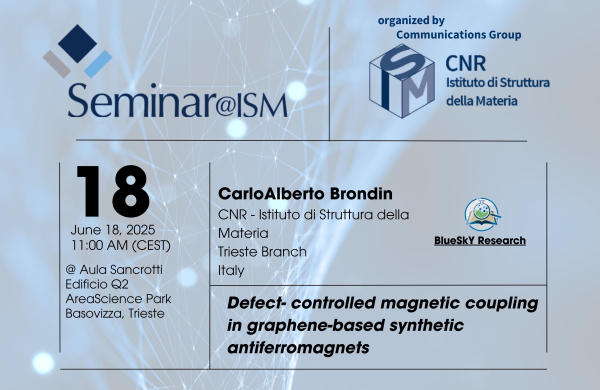Synthetic antiferromagnets (SAF) with compensated stray magnetic fields offer ideal features for driving topological magnetic structures, skyrmions in particular. Rare-earth free SAFs with perpendicular magnetic anisotropy can be readily fabricated by interposing a graphene spacer between ultrathin 3d transition metals. The prototypical system Fe/graphene/Co hides a surprising level of complexity when considering real interfaces. In our study, we experimentally and theoretically demonstrate the sensitive dependence of magnetic properties on the structural integrity of the graphene spacer.
Spectromicroscopy experiments with chemical, structural and magnetic sensitivity reveal the role of graphene defects in the Fe-Co magnetic coupling. The overall sign and magnitude of the Fe overlayer magnetization can be controlled by passivating graphene defects using nonmagnetic atoms and molecules. Density functional theory calculations confirm that the presence of graphene vacancy defects and metal overlayer clusters can induce ferromagnetic coupling in Fe/graphene/Co. Moreover, calculations demonstrate how the antiferromagnetic superexchange coupling between Fe and Co via the graphene spacer is disrupted at the graphene defects, and how it is restored by introducing nonmagnetic atoms at the defect sites. Restoration of antiferromagnetic coupling is confirmed in the experiments by using Ag atoms and carbon containing molecules to passivate the defect sites.
CarloAlberto Brondin is a postdoctoral researcher at CNR-ISM in Trieste Branch. He completed his Ph.D. through a joint doctoral program in Chemistry between Ca’ Foscari University of Venice and the University of Trieste.
During his doctoral studies, he worked at the Nanospectroscopy beamline of Elettra Synchrotron Trieste, focusing on magnetic anisotropy and magnetic coupling in graphene–ferromagnet hybrid systems.
At CNR-ISM, he collaborates with Alessandro Barla on the PRIN 2022 project (MAGNETISE), which investigates single-atom magnets. Their research involves introducing magnetic impurities into oxide matrices and analyzing the resulting magnetic and electronic properties using synchrotron-based techniques such as XMCD, EXAFS, XPS, and ARPES.
He currently serves as a reviewer for Physical Review Materials (PRM).


 English (UK)
English (UK)  Italiano (Italia)
Italiano (Italia)